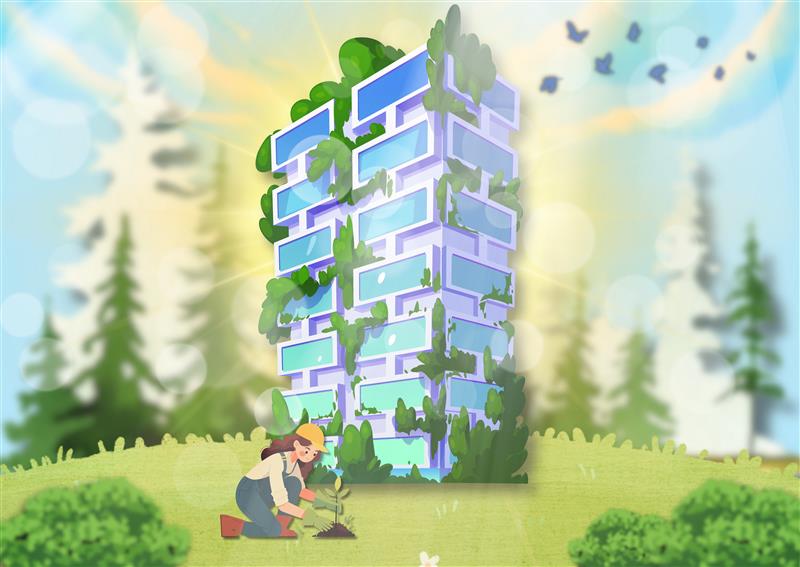03 February 2025

Greenlighting Greener Buildings: The Rise of Sustainable Architecture
The built environment drives 40% of global energy use and over 33% of greenhouse gas emissions, while urbanization accelerates demand for sustainable solutions. Sustainable architecture transforms construction by reducing environmental harm, optimizing resources, and enhancing resilience. It addresses ESG goals, improves quality of life, and aligns long-term sustainability with economic efficiency, positioning corporations as leaders in building a greener future.
Building on Values: The Core Principles of Sustainable Architecture
- Energy Efficiency
Sustainable buildings prioritize energy reduction through the integration of technologies such as energy-efficient lighting, smart HVAC systems, and renewable energy sources like solar panels and wind turbines. These efforts help mitigate climate impact while reducing operating costs. - Eco-Friendly Materials
The use of sustainable, locally sourced, and recycled materials (like bamboo, reclaimed wood, or recycled steel) reduces carbon footprints while minimizing construction waste. Water-saving technologies like greywater recycling and low-flow fixtures also contribute to resource efficiency. - Biophilic Design
Incorporating natural elements, such as green roofs, vertical gardens, and natural light, enhances occupant well-being. Studies link biophilic design to higher productivity and lower stress, making it an essential feature for modern workplaces. - Resilience to Climate Risks
Sustainable buildings are designed to withstand climate challenges, from flood-proof construction to heat-resistant materials, safeguarding both occupants and investments. - Circular Economy Approaches
Modular construction techniques and cradle-to-cradle material use promote a circular economy, ensuring materials are reused or recycled, minimizing waste throughout a building’s life cycle.
Trends Transforming Modern Buildings
- Green Certifications
Programs like LEED (Leadership in Energy and Environmental Design) and BREEAM provide benchmarks for sustainable practices, guiding developers toward energy efficiency, waste reduction, and healthier indoor environments. - Smart Building Technology
IoT-enabled tools, such as smart thermostats and energy management systems, optimize resource use in real time, cutting costs and emissions while improving efficiency. - Net-Zero Buildings
The concept of net-zero carbon buildings, which generate as much energy as they consume, is gaining momentum with advances in renewable energy and energy storage. - Prefabrication and Modular Construction
Prefabricated components reduce material waste, speed up construction, and cut transportation-related emissions, making them a sustainable choice for developers.
From Vision to Reality: World-Class Examples of Green Architecture
- The Edge (Amsterdam, Netherlands)
Touted as the world’s greenest office, it uses IoT technology to optimize lighting and energy use. Rooftop solar panels and rainwater harvesting systems showcase its resource efficiency. - Bosco Verticale (Milan, Italy)
Known as the "vertical forest," this residential building features 900 trees and 20,000 plants, improving air quality and reducing heat. - Bullitt Center (Seattle, USA)
A net-zero energy commercial building powered by solar panels and rainwater collection. - The Crystal (London, UK)
A fully electric building, it serves as a global hub for sustainable urban development.
The Corporate Case for Greener Buildings
Sustainable architecture is more than an environmental responsibility—it’s a strategic business decision. Here's why:
- Cost Savings
Energy-efficient buildings reduce operational costs through lower utility bills and maintenance expenses, providing financial benefits in the long term. - Regulatory Compliance
Governments are increasingly enforcing stricter green building codes and carbon reduction targets. Early adoption ensures compliance while avoiding penalties. - Attracting Stakeholders
In general, tenants prefer eco-friendly spaces that align with their values, and investors are prioritizing ESG-compliant projects. Green buildings often enjoy higher occupancy rates and premium rents. - Enhancing Reputation
Companies operating in sustainable spaces showcase leadership in climate action, bolstering brand reputation and stakeholder trust.
The Way Forward: Greenlighting the Future
The rise of sustainable architecture signals a decisive step toward a greener, healthier, and more resilient urban future. By committing to sustainable design, developers and corporations can drive meaningful progress while future-proofing their investments. Greenlighting greener buildings is not just a necessity—it’s an opportunity. It’s time to reimagine our built environment as a solution to the world’s greatest challenges. The decisions we make today will determine the future we build tomorrow.
References
1. The World Economic Forum. (2021). Why buildings are the foundation of an energy-efficient future?
2. Zavaleev, Ilya. (n.d). What is the difference between LEED and BREEAM systems? Which one is more effective?
3. Dodge Construction Network. (2021). World Green Building Trends 2021.
4. Porada, Barbara. (2023). The 'World's Greenest Commercial' Building Opens in Seattle Today.
Keywords:
Sustainable Architecture, Green Buildings, Energy Efficiency, Eco-Friendly Materials, Biophilic Design, Climate Resilience, Circular Economy, Smart Building Technology, Net-Zero Buildings, Modular Construction, Prefabrication, Green Certifications, LEED, BREEAM, Renewable Energy, Carbon-Neutral Design, Sustainable Construction, Green Building Trends, ESG Goals, Sustainable Urban Development, Green Building Materials, Sustainable Design, Smart HVAC Systems, Energy Management Systems, Building Sustainability, Sustainable Construction Techniques, Future-Proof Buildings, Sustainable Real Estate, Low-Carbon Architecture.
